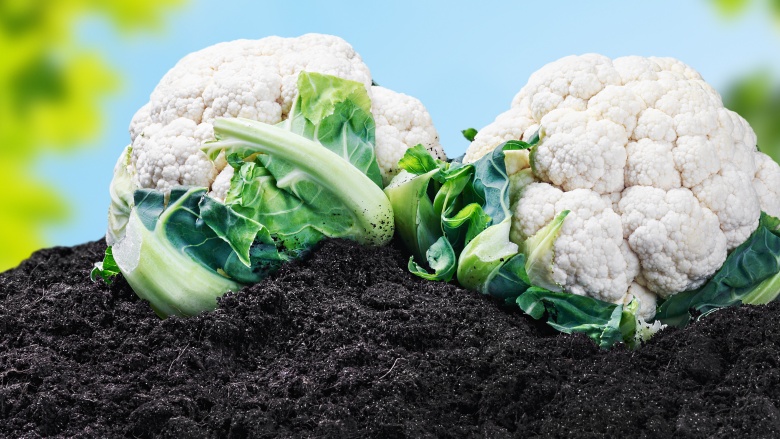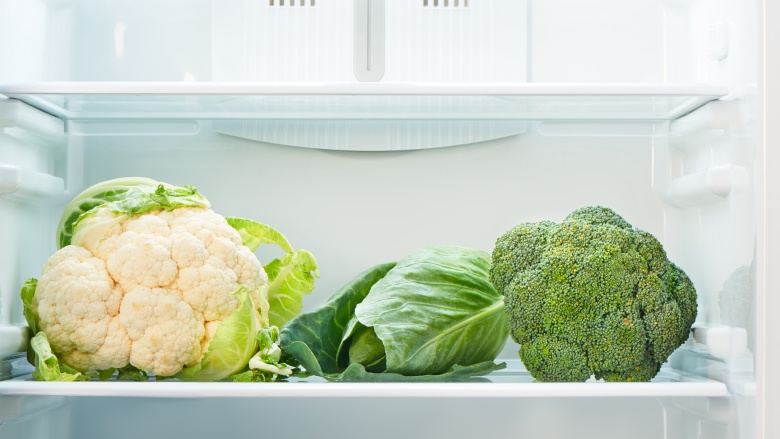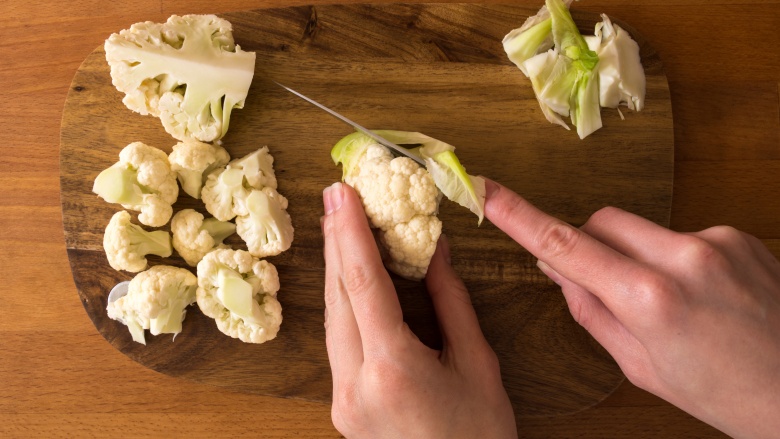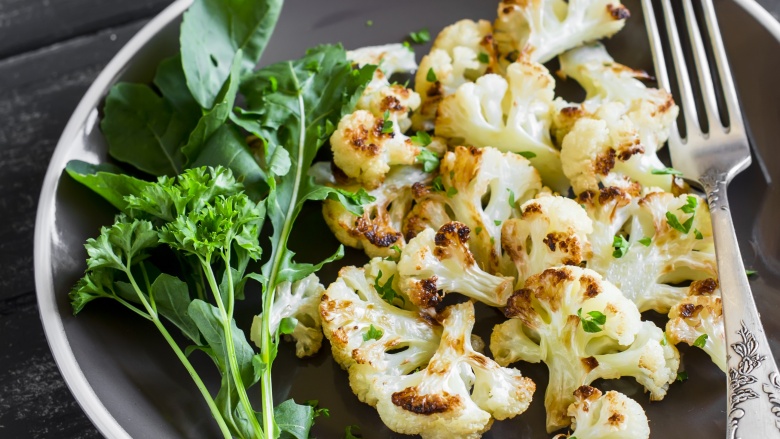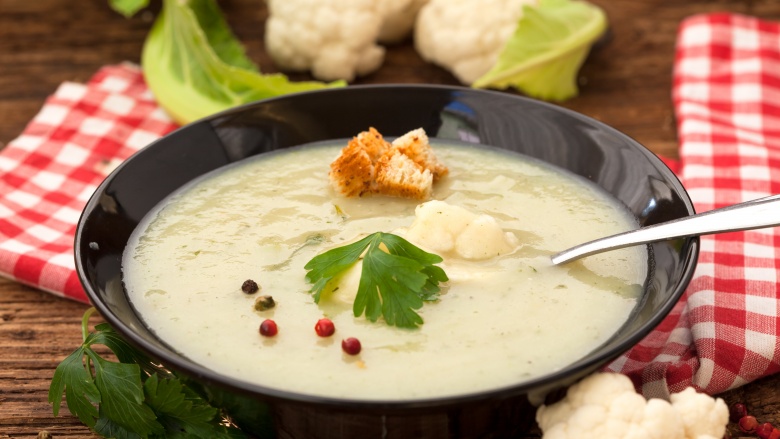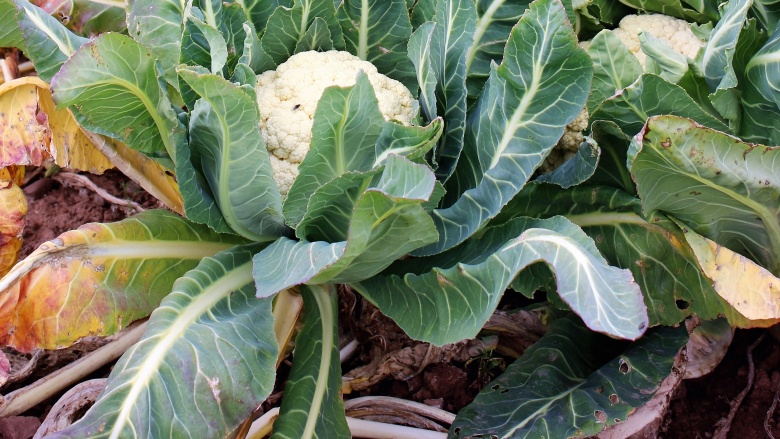How To Master Cauliflower
I am of the belief that cauliflower is having a moment, and it's about time. This versatile and inexpensive vegetable is made of densely packed florets that form the head — also called the curd. An outer layer of leaves lends protection from the sun during the growing period. And while the most common cauliflower hue is white, you can also find beautiful orange and purple varieties. Though it's in the same family as broccoli, cauliflower possesses a noticeably more compact head. I love cooking with it and do so often.
In addition to being delicious in various preparations, cauliflower is chock full of vitamins and minerals, including vitamin C and folate as well as potassium and magnesium. The best part? Whether you blend it into a warming soup, roast it for lunch, or stir-fry it in a wok, this unique vegetable comes out like a shining star. With its naturally nutty, sweet, and creamy flavor, it'll certainly help you get excited about eating your veggies.
Peak cauliflower season
While cauliflower is available year-round in most grocery stores and markets, they are at their best in the spring and fall, barring any extreme regional climates. Fall is soup weather, and cauliflower can help you get your fix. Spring is a perfect time for fresh salads, and cauliflower can star in these dishes as well. (We'll get to some notable recipes later on.)
How to choose your cauliflower
As with any produce, you want to pick the best head of cauliflower out of the bunch. Luckily, this vegetable is an open book when it comes to letting you see and feel all of its faults. The freshest head will have creamy white florets without brown spots or other blemishes. Spots tend to indicate that a cauliflower is a little older than is ideal. The stem should be firm and the leaves bright green and not wilted. This will tell you that the cauliflower was harvested recently. Go ahead and give it a sniff, too. There should be no discernible odor. A strong smell indicates its age.
Storing cauliflower
You should store your cauliflower in the fridge inside a perforated bag so it can breathe a bit. You want to minimize the moisture on the cauliflower itself. Wet, moldy cauliflower is no good! You can keep an uncooked head refrigerated for five to seven days and cooked cauliflower for up to three days. (It might have a little bit of a smell to it the longer you keep it, which is a nice reminder to use it soon.)
Preparing cauliflower
When you're ready to use your cauliflower, quarter the curd through the stem. Cut away the stem pieces attached to each quarter. If you're using the delectable leaves and stems, be sure to trim them to the same size as the florets you plan to cook. Throw everything in a colander and give it a good rinse to get rid of any remaining grit. Be sure to pat the florets, leaves, and stems dry before cooking so they can brown instead of steam.
Uses
From the stem to the leaves to the florets, all parts of the cauliflower can be eaten raw, which means you should start including cauliflower in any respectable veggie party platter you plan to prepare. As a cooked main dish or side dish, you'll fall in love with it anew when you discover how wonderful the flavor is paired with a complex vegetable, cream, or wine sauce. And cauliflower is no slouch when it comes to being a team player. Add pieces to your omelette, savory tart, or pasta for much-needed heartiness and texture.
Standard recipes
I love this simple recipe from Bon Appetit because it allows the cauliflower to bask in the spotlight. Prepared raw, the cauliflower is shaved thinly and tossed in a sweet and lemony vinaigrette along with a blend of delicate lettuces. A light dusting of nutritional yeast lends irresistible savory flavor.
Ree Drummond's recipe' for Food Network transforms dense, hearty cauliflower into an impossibly creamy soup with fragrant and nutty notes. Made with simple aromatics, chicken broth, and pureed cauliflower, this dish is the definition of comfort on a cool fall evening. I could eat this on all the days.
This ingenious vegetarian recipe from Epicurious makes a meaty meal out of thick slabs of cauliflower browned in a skillet and finished in the oven. The result is a vegetable-based dinner that approximates your favorite steak. When slathered with a briny, zesty sauce made with tomatoes and olives, cauliflower is instantly redefined.
Advanced recipes
Ina Garten's gratin for Food Network strikes the perfect balance between fancy and rustic — and best of all, cauliflower features prominently in this vegetarian take on a French classic. Boiled cauliflower is combined with a traditional butter-and-flour roux along with two kinds of cheeses. Baked with a layer of breadcrumbs on top, this creamy casserole is just the thing you need on a cool evening.
This elegant souffle recipe from Epicurious makes for a beautiful presentation that's well worth the time it takes to prepare. Finely chopped cauliflower is incorporated into a warmed mixture of flour, egg yolk, and milk, then combined with airy whipped egg whites. Baked until golden on top, this dish is as simple and sophisticated as they come. A decadent brown butter sauce for serving brings everything together.
This vegetarian lasagna recipe from Food Network reinvents the classic Italian dish and turns it into something complex, hearty, and ideal for Meatless Monday. In place of traditional beef, cauliflower is used as the filling. Paired with creamy ricotta, mozzarella, and whole wheat pasta sheets, this dinner is one you'll think about long after the last bite.
How to grow cauliflower
If, after trying out a few recipes, you decide you want to try your hand at planting your own cauliflower, more power to you! You can grow it right alongside your other vegetables. While it's relatively easy to grow, you'll need to be mindful of a few key factors.
For an early summer harvest, try planting cauliflower in mid-spring. If you'd rather harvest in the fall, you can plant in mid summer. While it requires a little over two months to yield a summer harvest, you'll only need about five weeks for an autumn one. For the healthiest cauliflower, try to plant in moist soil in an area with relatively cool temperatures. You can also start your seeds inside a greenhouse or other hotbed area. Once the plants are ready to be moved outdoors, you'll want to plant the cauliflower about 18 inches apart. Water them every five to seven days and fertilize frequently. For more info on how to grow cauliflower, check out Bonnie's Plants.
That's the scoop on cauliflower. If you've been spending all your time, money, and energy on cabbage and broccoli, I hope you'll now consider the humble but brilliant cauliflower for your next cooking sesh. Besides, if cauliflower is indeed having its moment, you don't want to miss the boat!

